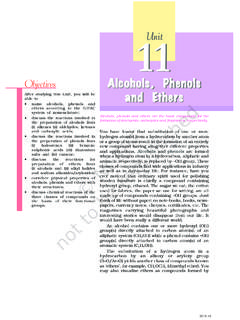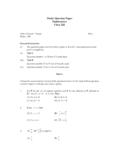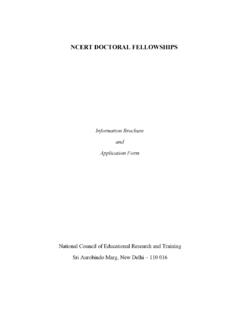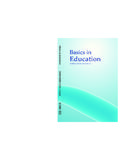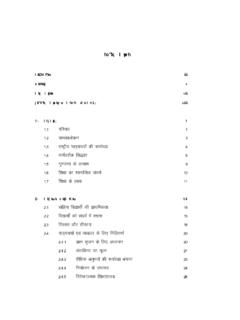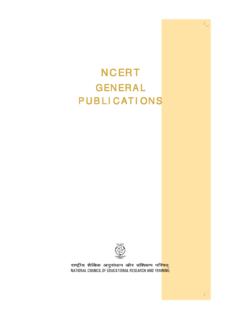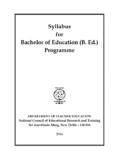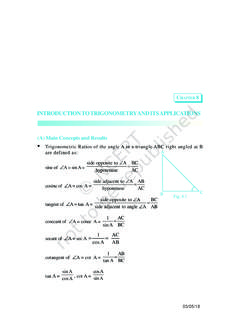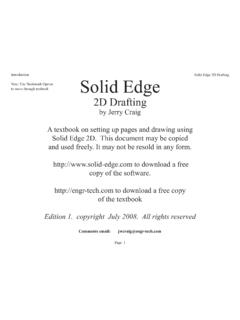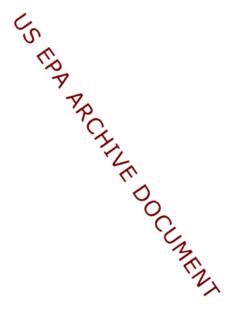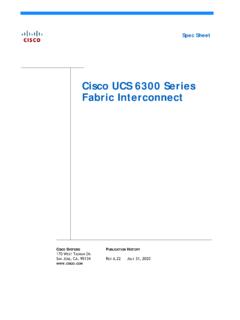Transcription of Visualising Solid Chapter 15 - NCERT
1 Visualising Solid INTRODUCTION: PLANE FIGURES AND Solid SHAPESIn this Chapter , you will classify figures you have seen in terms of what is known as our day to day life, we see several objects like books, balls, ice-cream cones etc.,around us which have different shapes. One thing common about most of these objects is thatthey all have some length, breadth and height or is, they all occupy space and have three , they are called three dimensional you remember some of the three dimensional shapes ( , Solid shapes) we have seenin earlier classes?
2 Match the shape with the name: Chapter 15 Visualising SolidShapesTRY THESEFig (i)(a)Cuboid(iv)(d)Sphere(ii)(b)Cylinder (v)(e)Pyramid(iii)(c)Cube(vi)(f)Cone2022 -23 MATHEMATICS278278278278278 Try to identify some objects shaped like each of a similar argument, we can say figures drawn on paper which have only length andbreadth are called two dimensional ( , plane) figures. We have also seen some twodimensional figures in the earlier the 2 dimensional figures with the names (Fig ):(i)(a)Circle(ii)(b)Rectangle(iii)(c)Sq uare(iv)(d)Quadrilateral(v)(e)TriangleFi g :We can write 2-D in short for 2-dimension and 3-D in short FACES, EDGES AND VERTICESDo you remember the Faces, Vertices and Edges of Solid shapes, which you studiedearlier?
3 Here you see them for a cube:(i)(ii)(iii)Fig 8 corners of the cube are its vertices. The 12 line segments that form theskeleton of the cube are its edges. The 6 flat square surfaces that are the skin of thecube are its Solid SHAPES279279279279279 Complete the following table:Table you see that, the two dimensional figures can be identified as the faces of thethree dimensional shapes? For example a cylinder has two faces which are circles,and a pyramid, shaped like this has triangles as its will now try to see how some of these 3-D shapes can be visualised on a 2-Dsurface, that is, on order to do this, we would like to get familiar with three dimensional objects us try forming these objects by making what are called NETS FOR BUILDING 3-D SHAPESTake a cardboard box.
4 Cut the edges to lay the box flat. You have now a net for that net is a sort of skeleton-outline in 2-D [Fig154 (i)], which, when folded [Fig154 (ii)],results in a 3-D shape [Fig154 (iii)].(i)(ii)(iii)Fig THISV ertexFaceEdgeFaceVertexEdgeFaces (F)64 Edges (E)12 Vertices (V)842022-23 MATHEMATICS280280280280280 Here you got a net by suitably separating the edges. Is thereverse process possible?Here is a net pattern for a box (Fig ). Copy an enlargedversion of the net and try to make the box by suitably foldingand gluing together.
5 (You may use suitable units). The box is asolid. It is a 3-D object with the shape of a , you can get a net for a cone by cutting a slit alongits slant surface (Fig ).You have different nets for differentshapes. Copy enlarged versions of the netsgiven (Fig ) and try to make the 3-D shapesindicated. (You may also like to prepareskeleton models using strips of cardboardfastened with paper clips).Fig could also try to make a net for making a pyramid like the Great Pyramid in Giza(Egypt) (Fig ).
6 That pyramid has a square base and triangles on the four if you can make it with the given net (Fig ).Fig (i)Cone(iii)Cylinder(ii)Fig Solid SHAPES281281281281281 Here you find four nets (Fig ). There are two correct nets among them to makea tetrahedron. See if you can work out which nets will make a the nets which can be used to make cubes (cut out copies of the nets and try it):(i)(ii)(iii)(iv)(v)(vi) are cubes with dots on each face. Opposite faces of a die always have a totalof seven dots on are two nets to make dice (cubes); the numbers inserted in each square indicatethe number of dots in that suitable numbers in the blanks, remembering that the number on theopposite faces should total to this be a net for a die?
7 Explain your THESE1 23 45 is an incomplete net for making a cube. Complete it in at least two differentways. Remember that a cube has six faces. How many are there in the net here?(Give two separate diagrams. If you like, you may use a squared sheet for easymanipulation.) the nets with appropriate solids:(a)(i)(b)(ii)(c)(iii)(d)(iv)Play this gameYou and your friend sit back-to-back. One of you reads out a net to make a 3-D shape,while the other attempts to copy it and sketch or build the described 3-D DRAWING SOLIDS ON A FLAT SURFACEYour drawing surface is paper, which is flat.
8 When you draw a Solid shape, the images aresomewhat distorted to make them appear three-dimensional. It is a visual illusion. You willfind here two techniques to help Oblique SketchesHere is a picture of a cube (Fig ). It gives a clear idea of how the cube looks like,when seen from the front . You do not see certain faces. In the drawn picture, the lengthsFig Solid SHAPES283283283283283are not equal, as they should be in a cube. Still, you are able to recognise it as a cube. Sucha sketch of a Solid is called an oblique can you draw such sketches?
9 Let us attempt to learn the need a squared (lines or dots) paper. Initially practising to draw on these sheets willlater make it easy to sketch them on a plain sheet (without the aid of squared lines or dots!)Let us attempt to draw an oblique sketch of a 3 3 3 (each edge is 3 units) cube (Fig ).Step 1 Step 2 Draw the front the opposite face. Sizes of thefaces have to be same, but the sketchis somewhat off-set from step 3 Step 4 Join the corresponding cornersRedraw using dotted lines forhidden edges.
10 (It is a convention)The sketch is ready the oblique sketch above, did you note the following?(i)The sizes of the front faces and its opposite are same; and(ii)The edges, which are all equal in a cube, appear so in the sketch, though the actualmeasures of edges are not taken could now try to make an oblique sketch of a cuboid (remember the faces in thiscase are rectangles)Note:You can draw sketches in which measurements also agree with those of a givensolid. To do this we need what is known as an isometric sheet.
